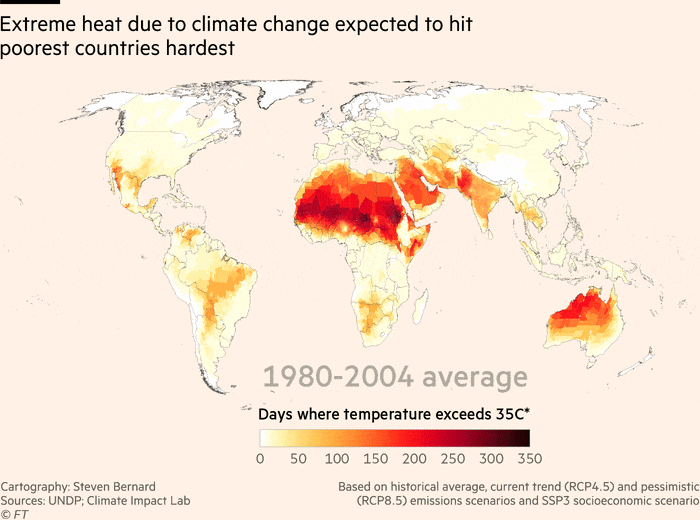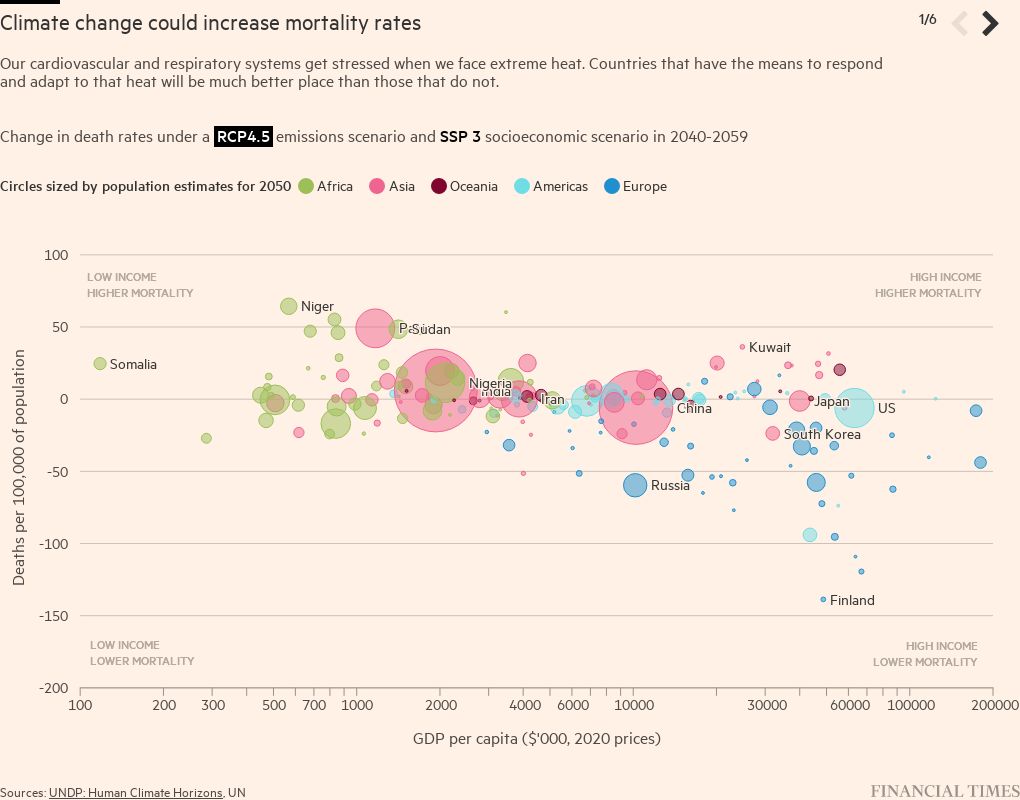Heat will almost double death rates in poorer Pakistan than richer Riyadh, scientists report

Roula Khalaf, Editor of the FT, selects her favourite stories in this weekly newsletter.
Global warming will worsen inequalities in health around the world and increase death rates faster in poorer countries than in wealthier ones, according to a coalition of scientists, economists and climate experts.
New research from the Climate Impact Lab concludes that low-income countries were disproportionately affected by extreme heat, as the negative health effects were exacerbated by restricted access to air conditioning and less developed healthcare systems, based on the historical data.
The study, which indicates greater climate-related mortality rates in developing countries than in wealthier ones, comes as world leaders land in Sharm el-Sheikh in Egypt for the UN climate summit.
The conference is expected to be dominated by fraught debate among nations over who pays for the costs of climate change, with the smaller, less wealthy nations most affected by a warming planet arguing that richer countries with higher emissions should help foot the bill.
In a scenario where countries meet their greenhouse gas emissions reduction pledges under the Paris Agreement, Faisalabad, Pakistan, could expect annual all-cause death rates to increase by 67 deaths per 100,000 people compared to a future with no climate change, the study’s authors found.
By comparison, in Riyadh, Saudi Arabia, more widespread access to electricity and healthcare would cause an increase of a comparably lower 35 extra deaths per 100,000 people, despite similar patterns of extreme heat being forecast.
“Just looking at this data you can think about the fact that this could have real impacts on human migration in even just the next 30 or 40 years,” said Hannah Hess, associate director at the independent Rhodium Group, a part of the climate lab.
As well as studying death rates, the group partnered with the UN Development Programme to project the effects of climate change on energy use and the labour force for countries and regions across the world.
Global warming will also drive small increases in electricity use around the world as people install more air conditioning, the data set found, although the biggest rises in consumption were concentrated among the richest 10 per cent of the global population.
Middle-income populous countries including China, India, Indonesia and Mexico were all forecast to increase electricity consumption partly as a result of expanded access to electricity.
The data project also tries to capture the productivity lost per worker per year in weather exposed sectors, such as construction, mining and agriculture. It accounts for the existing country trends of people moving from work in climate-exposed sectors and into lower-risk sectors.
In countries that already face extreme heat, such as Cameroon and Malaysia, workers in high risk sectors could face interruptions of more than 15 hours annually compared to a world with no climate change, the researchers found.
Hess said workers would need to adapt to rising temperatures. “A really illustrative example is the World Cup Stadium being built in Qatar” said Hess. “If you look at the construction workers — what they’re wearing to work in this hot sun is huge helmets, they have suits and they’re constantly taking breaks”.
The World Bank released a report on the threat of climate change to development objectives this week that showed the investment needed to lower carbon emissions are much higher in the low income countries that are most vulnerable to climate change.
The World Bank found that an average annual investment of 1.4 per cent of GDP between 2022 and 2030 could lower emissions in developing countries by as much as 70 per cent by 2050.
But for lower income countries, financing equivalent to 5 to 8 per cent of their GDP annually between 2022 and 2030 would be required.
The Bank’s review covers 20 countries that account for around a third of the world’s greenhouse gas emissions. The report mainly covers African and Asian countries, including China.
Methodology for data used in map and charts
Climate Capital

Where climate change meets business, markets and politics. Explore the FT’s coverage here.
Are you curious about the FT’s environmental sustainability commitments? Find out more about our science-based targets here

Comments